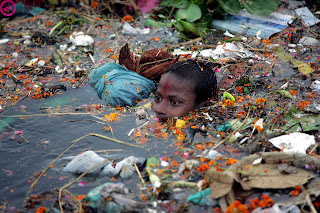Air Pollution
NEA
regulates sources of air pollution, imposing minimum standards to ensure that
emissions remain at acceptable levels to ensure that Singapore has clean and
safe air. Emission standards are specified in the Environmental Protection and Management (Air Impurities) Regulations.The
main targets of NEA’s air pollution regulations are industrial operations, power
generation plants and motor vehicles.
Sulphur Dioxide (SO2)
Emission Inventory
SO2
emissions are a major issue in Singapore given off mainly by refineries, power
stations, other industries, cargo ships. As shown below is the emissions data collected from
various sources in 2007.
During
that period of time when industrialization has grown rapidly and emissions were
extreme, Singapore had specifically reclaimed a piece of land, Jurong Island,
for industrial purposes.
Sources
|
Emitters
|
SO2 Emissions (tonnes)
|
Contribution of SO2 Emissions
|
Refineries
|
Shell
|
28,278
|
51%
|
Singapore Refining Company
|
26,754
|
||
ExxonMobil
|
22,421
|
||
Power Stations
|
Power Seraya
|
14,194
|
|
Tuas Power
|
18,382
|
27%
|
|
Senoko Power
|
7,754
|
||
Shipping
|
-
|
28,026
|
18%
|
Other Industries
|
Sembcorp Utilities
and Terminals
|
748
|
3%
|
ExxonMobil
Petrochemical
|
722
|
||
Linde Syngas
|
546
|
||
Mitsui Phenol
|
436
|
||
Petrochemical
Corporation of Singapore
|
208
|
||
Invista
|
3
|
||
Other Fuel Oil Users
|
1,300
|
||
Diesel Users
|
46
|
||
Motor Vehicles
|
Petrol Vehicles
|
891
|
1%
|
Diesel Vehicles
|
101
|
||
Total
|
150,810
|
100%
|
I think that by isolating the industrial
area, away from residential and working places, people are less likely to be
affected by the harmful toxins and chemicals released by the factories. Although
this method does not help in overcoming air pollution, it helps to improve the
problems that come along with air pollution (e.g.: haze, health conditions of
the people)
Industrial Emissions
The
NEA’s Source Emission Test Scheme for industries requires industries to conduct
source emission test on their own or engage accredited consultants to do so on their behalf. This helps industries
to monitor their air emissions regularly and to take measures, to ensure
compliance with the prescribed air emission standards.
By implementing
regulations, standards and having tests, factories have to abide certain rules and
meet certain criteria. Those who failed to meet the standards are penalised and
have to pay heavy fines. I feel that this system will benefit air pollution in
Singapore greatly because factories are mindful of what they should or not
release in order not to pay the fines or be “black-listed”. Also, enforcing
rules are inexpensive ways of controlling gases emissions, only the
co-operation of the people has to be sought for.
Motor Vehicles
Motor
vehicles are a major source of air pollution. To control the emissions
generated by motor vehicles, NEA regulates the type and quality of fuel that
can be used in Singapore, and also sets minimum exhaust emission standards for
all vehicles.
NEA
takes stringent enforcement actions against smoky vehicles on the roads.
Regulation 19 of the Environmental
Protection and Management (Vehicular Emissions) Regulations
stipulates that it is an offence for any person to use or permit the use of any
smoky vehicle on the road.
It
is the responsibility of every owner of a vehicle to ensure that the vehicle is
in good condition before using it on the road. Besides carrying out proper
servicing and maintenance of the vehicle regularly, the driver must also not
overload the vehicle or drag the engine of the vehicle while driving. For
2-stroke motorcycles, the cause of white smoke emissions is usually due to
addition of lubricating oil in excess of the amount specified in the vehicle
manufacturer’s manual.
Again, law enforcing
requires more of the peoples’ cooperation than funds hence its economically-friendly
and would also prove beneficial since drivers will most likely keep their vehicles
in good conditions and go for vehicle-checks than pay additional taxes or
fines.
Off-Road Diesel Engines
With effect from 1 July 2012, all off-road
diesel engines to be imported for use in Singapore are to comply with the EU Stage II, US Tier II or Japan Tier I off-road diesel engine emission
standards. Off-road diesel engines are any equipment or machinery that is
equipped with diesel engines as the main or auxiliary prime mover and not
registered with the Land Transport Authority (LTA) for use on public roads.
Examples of off-road diesel engines include construction equipment such as
cranes, excavators, forklifts and power generators. Diesel engines used in
ships, railways, locomotives and aircraft do not fall under this
regulation.
All newly-imported off-road diesel engines, both
new or used, intended for use in Singapore must comply with the stipulated
emission standards with effect from 1 July 2012. This regulation includes those
with engine power above 560kW. The engine or off-road diesel equipment can be
sent to an overseas or Singapore accredited laboratory for an emissions
test according to the ISO 8178 standards.
Allowing only specific types of diesel
engines ensures standardisation. People either abide the rule set or pay fines.
This form of using money to control people from releasing harmful chemicals and
gases encourage Singaporeans to play their role in managing air pollution and
the results could be as good as buying or building new machines which help clear
toxic air.















